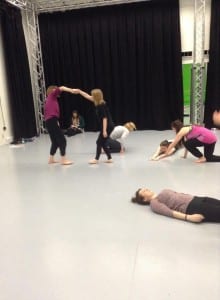Tuesday 25th February 2014
A sense of where you are going gives the dancer a clear pathway for exploration. This doesn’t mean that you need to know what you are going to do next when in contact improvisation; it does however mean that if your body wants to move in a certain direction, in a certain way at a certain speed, let it. Sensing movement and direction should be a natural understanding, meaning that a dancer can be in the moment and allow the sensation of the movement and centre of gravity to guide them through the space and exploration. This means allowing your body to have a sense of spontaneity and surrender.
Change of direction through centre of gravity and weight distribution was our focal point during this class, along with active and passive focus. ‘Will and Surrender. Force and weight.’ (Silverthorn, 2014) were words that were given to us in the beginning of the class. We were asked to remember these throughout the class as contrasting feelings when in contact movement.
Today I was personally breaking the boundary of will and surrender. We began today by breaking boundaries with one another, seeing how close we could get to another person until they started to feel uncomfortable and experimented with choice. This allowed me to work with other who I haven’t before. I explored will and surrender with Emily today and the feeling was mutual as to how interesting the movement can be when you sense the other persons limitations. Knowing how far you can push spontaneity is a key understanding. It was difficult beginning but once we let go and went with our bodies it became fluent and comfortable and the centre of gravity found itself. I think it became clear to the both of us that even though you want to break those boundaries that you may personally have it cannot be done in one meeting. Exploration in yourself and with others is needed to find out exactly what those boundaries are and if in fact you have any boundaries. Sometimes it is just a state of concern as to what might happen if you experiment with something you haven’t before.
‘In many situations, the idea of centre of gravity alone is not enough for analyzing the mechanics.’ (Woodhull, 1978, 47) here Woodhull is explaining that the mechanics of the movement in contact is not just focused around centre of gravity, space in the body along with how you hold yourselves and the control of the movement are also needed. Peoples comfort zones are now clear as well as our own, which I feel is a very important aspect of contact. We all used spontaneity in our work today which allowed experimentation of direction and sensing weight to be broadened.
Work cited:
Silverthorn, T. (2014) Releasing the head and activating the eyes [seminar] Contact Improvisation: An Ongoing Research Lab DAN2005M, University of Lincoln, 25 February.
Woodhull A. (1978) Center of Gravity. Contact Quarterly/ Contact
Improvisation Sourcebook I Vol. 4. Pp. 43-48.
